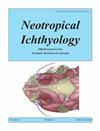Taxonomy of the armored catfish genus Aspidoras (Siluriformes: Callichthyidae) revisited, with the description of a new species
IF 2
4区 生物学
Q1 ZOOLOGY
引用次数: 3
Abstract
Abstract Aspidoras comprises 25 species currently considered as valid, being widely distributed in Brazil, occurring from the upper rio Paraná basin in São Paulo to coastal basins of Ceará. After Nijssen, Isbrücker’s review more than 40 years ago, no extensive work regarding the taxonomy of Aspidoras was conducted. Our paper presents a comprehensive taxonomic revision of the genus, based primarily on the extensive material that has been collected since then. Considering the new diagnosis plus the available phylogenetic data, A. pauciradiatus and A. virgulatus are transferred to Corydoras and Scleromystax, respectively. New synonymies are proposed: A. eurycephalus and A. taurus with A. albater; A. menezesi and A. spilotus with A. raimundi; and A. microgalaeus and A. marianae with A. poecilus. Additionally, a new species from the Araguaia and Paraguay river basins is described, which can be distinguished from its congeners by the morphology of its complex vertebra and infraorbital 1. Thereby, the number of valid species within Aspidoras was reduced from 25 to 18. Redescriptions for A. albater, A. belenos, A. depinnai, A. fuscoguttatus, A. lakoi, A. maculosus, A. poecilus, A. psammatides, A. raimundi, and A. velites are provided. An identification key to the species of Aspidoras is also provided.重新研究了有甲鲶鱼属的分类学(蛭形目:有甲鲶鱼科),并描述了一新种
摘要:蜘蛛属(aspidora)包括目前公认的25种,广泛分布于巴西,分布于巴西圣保罗(o Paulo)的上里约热内卢paran盆地至塞埃尔 (cerar)沿海盆地。在Nijssen, isbr cker在40多年前的综述之后,没有进行过关于蜘蛛分类的广泛工作。我们的论文提出了一个全面的分类修订属,主要基于广泛的材料,已收集自那时起。考虑到新的诊断和现有的系统发育资料,A. pauciradiatus和A. virgulatus分别被转移到Corydoras和scleroomystax。提出了新的同义词:A. eurycephalus和A. taurus与A. albater;梅内泽伊螨、斯皮努伊螨与雷蒙伊螨;微galaea和marianae与poecilus。此外,还描述了一种来自阿拉瓜亚和巴拉圭河流域的新种,通过其复杂的椎骨和眶下的形态可以将其与同类区分开来。因此,蛛形纲内的有效种数从25种减少到18种。给出了拟南拟南拟南、拟南拟南、拟南拟南、拟南拟南、拟南拟南、拟南、拟南、拟南、拟南、拟南、拟南、拟南、拟南、拟南、拟南、拟南、拟南、拟南、拟南、拟南、拟南、拟南、拟南、拟南、拟南。并提供了蜘蛛属的鉴定钥匙。
本文章由计算机程序翻译,如有差异,请以英文原文为准。
求助全文
约1分钟内获得全文
求助全文
来源期刊

Neotropical Ichthyology
生物-动物学
CiteScore
2.80
自引率
17.60%
发文量
24
审稿时长
6-12 weeks
期刊介绍:
Neotropical Ichthyology is the official journal of the Sociedade Brasileira de Ictiologia (SBI). It is an international peer-reviewed Open Access periodical that publishes original articles and reviews exclusively on Neotropical freshwater and marine fishes and constitutes an International Forum to disclose and discuss results of original research on the diversity of marine, estuarine and freshwater Neotropical fishes.
-Frequency: Four issues per year published only online since 2020, using the ‘rolling pass’ system, which posts articles online immediately as soon as they are ready for publication. A searchable and citable Digital Object Identifier (DOI) is assigned to each article immediately after online publication, with no need to await the issue’s closing.
-Areas of interest: Biology, Biochemistry and Physiology, Ecology, Ethology, Genetics and Molecular Biology, Systematics.
-Peer review process: The Editor-in-Chief screens each manuscript submitted to Neotropical Ichthyology to verify whether it is within the journal’s scope and policy, presents original research and follows the journal’s guidelines. After passing through the initial screening, articles are assigned to a Section Editor, who then assigns an Associate Editor to start the single blind review process.
 求助内容:
求助内容: 应助结果提醒方式:
应助结果提醒方式:


